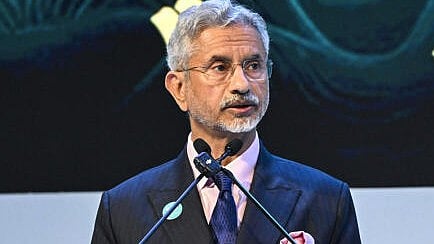
External Affairs Minister S Jaishankar addresses during the inaugural session of the 8th Indian Ocean Conference, in Oman.
Credit: PTI Photo
New Delhi: External Affairs Minister S Jaishankar on Sunday reaffirmed New Delhi’s commitment to ensure stability and security in the extended maritime neighbourhood comprising Indian Ocean nations – just days after United States President Donald Trump’s administration acknowledged India’s role as a ‘net security provider’ in the region.
Jaishankar noted that the two ends of the Indo-Pacific region were going through the sharpest churns – the conflict in West Asia on one end and “deeper tensions and sharper contestations” in the Indo-Pacific on the other end.
“In a volatile and uncertain era, we seek stability and security as the baseline. But beyond that, there are ambitions and aspirations that we strive to achieve. They will be easier reached when we look out for each other, supplement our strengths and coordinate our policies,” the external affairs minister said in a keynote address at the Indian Ocean Conference 2025 in Muskat, adding: “I can assure you all that India will be in the forefront of these endeavours.”
His reassurance to the nations in the maritime neighbourhood of India came days after a joint statement issued after Trump’s recent meeting with Prime Minister Narendra Modi in Washington DC conveyed the US support for “India’s role as a developmental, humanitarian assistance and net security provider in the Indian Ocean region” – sending out a message to China.
Modi and Trump committed to deepening India-US bilateral dialogue and cooperation across the vast Indian Ocean region and launched the Indian Ocean Strategic Venture, a new bilateral, whole-of-government forum to advance coordinated investments in economic connectivity and commerce.
Jaishankar on Sunday highlighted New Delhi’s role in stabilising Indian Ocean economies and societies that came under stress. He cited the example of India’s $4 billion financial package to Sri Lanka to stabilise the island nation’s economy, which had slid into a crisis.
He also noted that India had increasingly been active “in a First Responder mode” in the Indian Ocean region, be it in the wake of the conflict in Yemen, natural disasters in Mozambique, Sri Lanka or Myanmar, or earthquake in Nepal and Türkiye, or a water crisis in the Maldives, or oil spills off Mauritius and Sri Lanka. The external affairs minister referred to connectivity initiatives like India- Middle East-Europe Economic Corridor (IMEC), India-Myanmar Thailand Trilateral Highway (IMTT), and International North-South Transport Corridor (INSTC).
“In a world of increasing traditional and non – traditional threats in the maritime domain, it is essential that there is a common operating picture as well as shared platforms,” Jaishankar said at the conference themed “Voyage to New Horizons of Maritime Partnership”. “The International Fusion Centre located outside Delhi aims to do just that. By establishing coastal surveillance radars and partnering on White Shipping agreements, maritime traffic is made safer and more secure for our collective benefit,” he added.
“Extreme situations sometimes require a robust countering, including through the deployment of naval forces. For more than a year now, India has been doing precisely that in the Northern Arabian Sea and the Gulf of Aden,” the external affairs minister said apparently referring to the role of the Indian Navy in protecting the merchant vessels from the attacks by the Houthis based in Yemen.
He said that the scenario in the Indo-Pacific was intrinsically maritime in nature, involving respect for and observance of international law. There are other concerns, some related and some autonomous. Stronger assertions of interests were one issue; concern about unilateral changes to the status quo was another. “From India’s own experience, we can say that adhering to agreements and understandings is a central element in ensuring stability and predictability,” he said, tacitly referring to China’s violation of border agreements with India in April-May 2020, leading to a four-and-a-half-year long military stand-off in eastern Ladakh.
